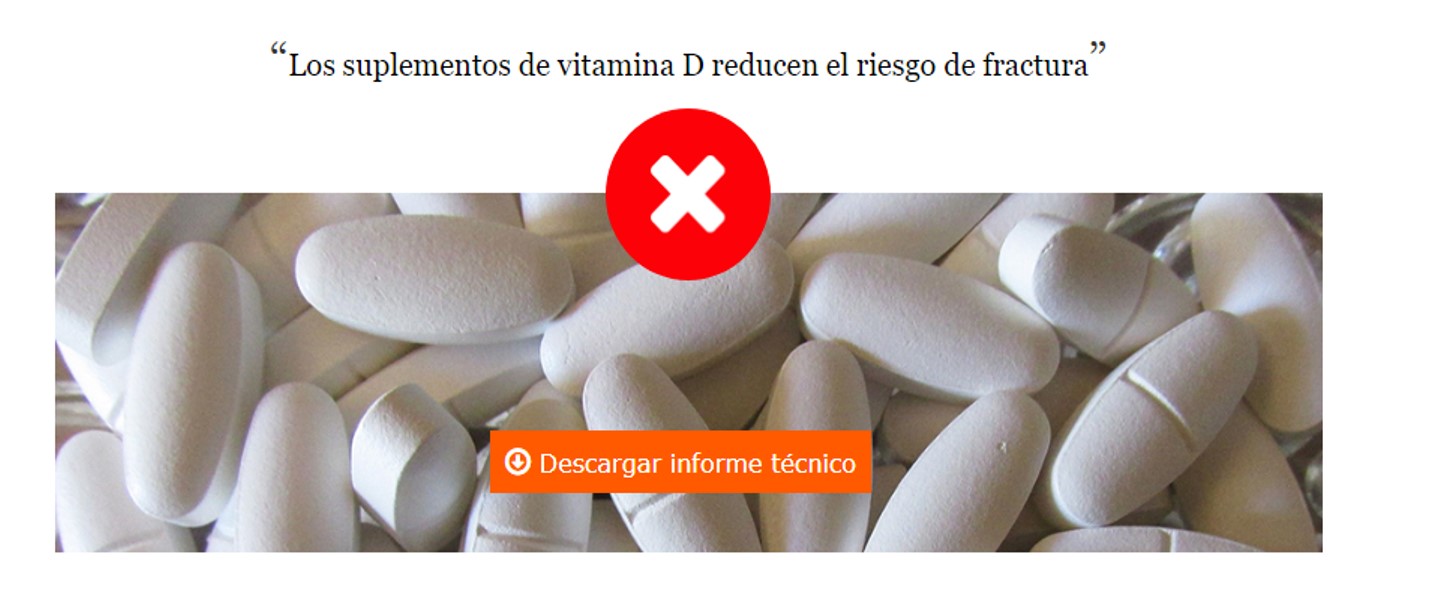Vitamin D supplements do not prevent bone fractures in the general population
Vitamin D supplements do not prevent bone fractures in the general population
According to a new Nutrimedia evaluation. A project led by Gonzalo Casino, professor with the Department of Communication, at the Science Communication Observatory and the Iberoamerican Cochrane Center, with the support of the Spanish Foundation for Science and Technology.

Concern about possible low vitamin D levels in the population has led in recent decades to dietary recommendations and nutritional supplements to increase their intake. These recommendations were made to improve bone health and prevent fractures, particularly of the hip, in the medium term. Some organizations, however, had already begun to question these recommendations.
Screening and supplementing with vitamin D generally may respond to a fashion rather than a necessity, with consequences such as medicalization and increased health spending
A new analysis by Nutrimedia belies the belief that vitamin D supplements reduce the risk of fractures in the general population. Nutrimedia is a project of the Science Communication Observatory (OCC) of Pompeu Fabra University (UPF), led by Gonzalo Casino, professor with the Department of Communication at UPF, and in collaboration with the Iberoamerican Cochrane Center, also supported by the Spanish Foundation for Science and Technology.
“It is true that at first, we see that the results of studies showed a decrease in fractures among older women residing in nursing homes or at long-stay centres; but recent reviews have questioned the effect”, explains Pablo Alonso Coello, a researcher at the Iberoamerican Cochrane Center and author of the evaluation.
The degree of certainty of the research results is high, so is highly unlikely that further studies will change this result
“It is a highly exhaustive systematic review that evaluates 81 studies with a total of more than 50,000 participants. The design and implementation of these studies, as well as the consistent effect observed, allow us confidently to confirm the absence of a protective effect in the general population; therefore, we believe that future studies are most unlikely to change the results observed in this new evaluation”, adds Alonso Coello.
The evaluation also mentions the recently published VITAL study, which shows that the consumption of vitamin D supplementation also reduces the risk of cancer or cardiovascular disease.
As this Nutrimedia analysis shows, there are specific cases where vitamin D supplementation would be indicated by medical prescription, such as, for example, for people who suffer osteomalacia or rickets.
The sunshine vitamin
 Vitamin D is a fat-soluble vitamin that helps to take advantage of the calcium we get from our diet and build bones. Vitamin D also regulates the parathyroid hormone (PTH), which helps maintain blood calcium levels. When there is a serious lack of this vitamin, children can develop rickets (bone deformities and weakness) and adults can develop osteomalacia.
Vitamin D is a fat-soluble vitamin that helps to take advantage of the calcium we get from our diet and build bones. Vitamin D also regulates the parathyroid hormone (PTH), which helps maintain blood calcium levels. When there is a serious lack of this vitamin, children can develop rickets (bone deformities and weakness) and adults can develop osteomalacia.
The lack of vitamin D also increases the risk of osteoporosis and bone fracture among the elderly. This vitamin is known as the sunshine vitamin because it is synthesized in the skin by the effect of the sun’s rays. This is the main source of vitamin D, and we obtain other smaller amounts from oily fish, egg yolk, cheese and some mushrooms, among others.
Dietary supplements of vitamin D would only be recommended in older women with a major nutritional deficit who cannot get exposure to the sun
In countries where the sun shines by its absence, the population is at greater risk of problems caused by a lack of vitamin D, but this should not be the case for the Mediterranean countries. An article published in the journal Science of the Total Environment proposes 10 minutes of sun exposure in the spring and summer, 30 minutes in the autumn and just over two hours in winter, in sunny countries.
However, some changes in lifestyle, such as spending less time outdoors or the use of sunscreen, states of malnutrition or the use of drugs that interfere with the absorption of vitamins, to highlight just a few, could lead to vitamin D deficiency.
What do we mean when we speak about desired levels? It is a controversial issue, since there is no scientific consensus about this. The United States’ National Academy of Science’s Institute of Medicine indicates that about 97.5% of the general population meets the vitamin D requirements, with values above 20 ng/ml, while a review of studies published in the British Journal of Nutrition notes that 88% of the world population could suffer from lack of vitamin D.
A twist in the recommendations
Another of the conclusions of the report by Nutrimedia is for the guidelines to stop recommending vitamin D supplementation, as stringent organizations such as the Preventive Services Task Force in the US is beginning to do, advising against vitamin D supplements for primary prevention of fractures in post-menopausal women.
The Preventive Activities and Health Promotion Programme recommends a diet rich in calcium and vitamin D, avoiding a sedentary lifestyle and smoking, and exposure to the sun for 10 minutes a day
In our environment, we should mention the guidelines of the Preventive Activities and Health Promotion Programme (PAPPS), published by the Spanish Society of Family and Community Medicine (semFYC), which recommends a diet rich in calcium and vitamin D, avoiding a sedentary lifestyle and smoking, and exposure to the sun for 10 minutes a day, while supplementation is relegated to very specific cases.
Alberto López, family doctor and coordinator of the women’s group within the PAPPS, appeals to common sense: “in some circumstances it makes sense to supplement, as in the case of elderly women who have nutritional deficits and cannot go outside, and even light institutionalized women, that is to say, women who move from their village to a flat in town and have to stay at home”. And he adds that screening and supplementing with vitamin D generally may respond to a fashion rather than a necessity, with consequences such as medicalization and increased health spending.
- Evaluation: https://www.upf.edu/web/nutrimedia/-/es-un-mito-que-los-suplementos-de-vitamina-d-prevengan-las-fracturas-en-la-poblacion-general
- Full technical report: https://www.upf.edu/documents/35405748/215868981/26-vitaminaD-7g.pdf/64287ab8-c5f0-82c6-82ce-539a3faa901b
